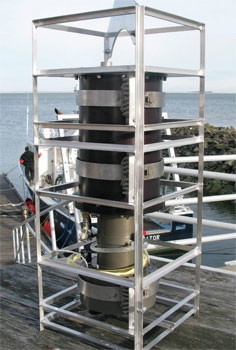
An underwater system that can analyse many types of microscopic organisms and particles in oceans, lakes, reservoirs and streams, and then rapidly transmit that data to scientists, is about to hit the market. Designed by Fluid Imaging Technologies (FIT), a company based in Yarmouth, Maine, the system works at depths up to 200m.
The Submersible FlowCAM can be attached to a stationary underwater mount, buoys or moorings, carried in the payload bays of underwater robots, or towed, providing more accurate data faster and more cheaply than taking water samples and carrying them back to a laboratory for analysis.
The FIT team worked with scientists from Ohio-based Battelle, who were responsible for developing the pressure-vessel housing that protects the instrument and the equipment that collects the water for analysis. FIT designed the system that fits inside this, which classifies images of the waterborne organisms.
According to Harry Nelson, director of aquatic sales and marketing at FIT, the system combines the capabilities of a flow cytometer with a digital imaging system. Like a flow cytometer, the system can measure the optical properties of particles in water, but it is also able to capture images of those particles. Using the FlowCAM’s image-recognition software Visual Spreadsheet, the user can determine, for example, what organisms are found in the water.
The system comprises a flow chamber, into which seawater is pumped; an optical system that contains light sources, detectors and other optics; and an electronic system that controls the overall operation of the instrument, as well as performing the capturing and processing of the images and the data gathered.
More accurate plankton tracking would allow better understanding of carbon dioxide in the oceans
To detect particles within the drawn water, a beam of laser light interacts with the particles in the water as they flow through the flow chamber. Each suspended particle passing through the beam either scatters the light or emits a fluorescence signal from the natural pigments in the organism. These events ’trigger’ the camera to capture an image of the particle.
The combination of scattered and fluorescent light is picked up by three detectors -one of which detects the scattered light from the sample, while two photomultiplier tubes detect the fluorescence of particles.
The electric currents created from the light scattered into the detector, or created when the fluorescent light hits the photomultiplier tubes, can also be selectively used to trigger a flash LED that backlights the sample, as well as a frame grabber that then captures an image of the sample from a CCD camera and records it. By triggering the system in such a fashion, it is unnecessary to take continuous samples over a preset time interval, reducing the amount of data that needs to be analysed.
The captured particle images are then automatically classified using statistical pattern-matching techniques that compare the images with those of groups from libraries of known particle images. The data can be retrieved from the system directly through a cable connected to the unit or from radio telemetry. Data can also be stored and retrieved at a later date.
Nelson said that the submersible FlowCAM could help researchers better understand the interaction of plankton -the primary producers in water systems -with their environment.
This will give biologists in fisheries greater insights into the world’s fisheries, as well as allowing climate-change researchers’ tools to construct better climate models by enabling them to more accurately track the growth, death and decay of ocean plankton, which would lead to a better understanding of the uptake and release of carbon dioxide in the oceans.
A prototype of the system is currently undergoing trials in Boston Harbour, Massachusetts.
design essentials
The key facts to take away from this article
- FlowCAM measures particles’ properties, as well as imaging them
- It comprises a flow chamber and optical and electronic systems
- Particles are detected in the water using a beam of laser light




Glasgow trial explores AR cues for autonomous road safety
They've ploughed into a few vulnerable road users in the past. Making that less likely will make it spectacularly easy to stop the traffic for...